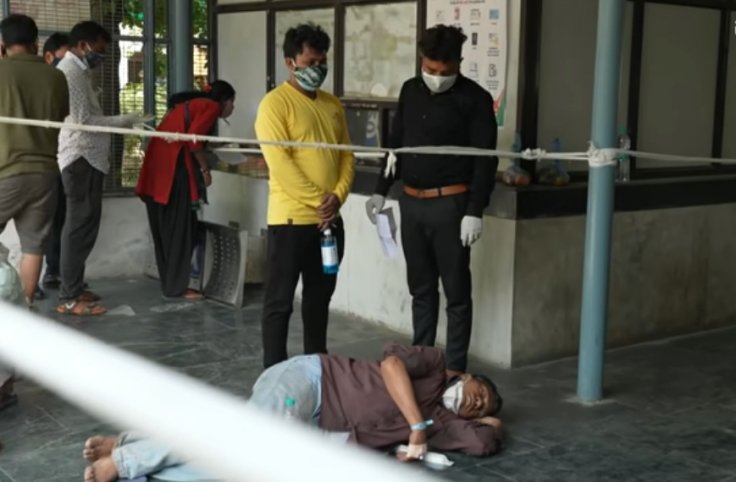The struggle to procure oxygen continues in India, as thousands fail to find hospital beds and pathetically suffocate on streets, with the second wave of Covid-19 wreaking havoc in the country. The Indian government finally woke up to crisis last week, setting up temporary oxygen plants and even some steel plants volunteering to supply hundreds of metric tons of liquid oxygen.
However, the crisis seems to be far from over. Lack of bottles and hoarding of oxygen cylinders has seen relatives of Covid-19 patients queue up for over 48 hours to buy cylinders an exorbitantly inflated price — at times even paying $500 for a single cylinder.

Faced with the crisis, the Indian government permitted on Friday to import oxygen concentrators for personal use, through post, courier or e-commerce portals, under the gift category. The exemption for oxygen concentrators is allowed till July 31, for personal use, according to a notification of the Directorate General of Foreign Trade (DGFT) published on April 30. However, the challenge now lies somewhere else.
What's an Oxygen Concentrator?
Oxygen concentrator is an option although not the best alternate to an oxygen cylinder. However, it now seems it's the best given the crisis and at least can help patients who have an oxygen saturation level between 90 and 94. They can depend on an oxygen concentrator and can use it at home.
Anyone with oxygen saturation depleting below 80-85 should ideally switch to a cylinder or liquid medical oxygen supply.

There are two varieties of oxygen concentrators — one with continuous flow and the other with pulse dose. Continuous flow concentrators provide the same flow of oxygen every minute unless it is turned off irrespective of whether patient is breathing it in or not.
The pulse dose oxygen concentrator detects the breathing pattern of the patient and dispenses oxygen accordingly, which means it is partly automated as its can detect inhalation and supplies the oxygen accordingly. In this case, the oxygen dispensed per minute will vary.
The Mechanism

Normal air has 21 percent oxygen, which is perfect for a clinically fit personal. When Covid-19 attacks, it creates breathing problem wherein the person's lungs fail to suck the required oxygen available in air. A concentrator helps in this case but one needs to know that most important thing for a concentrator to work is uninterrupted electric supply.
Once the concentrator is plugged in, it starts sucking in atmospheric air. It then filters the nitrogen and other gases, and compresses the remaining oxygen and dispenses it through the cannula. If 1 liter oxygen is provided to a patient through a concentrator, the oxygen percentage in lungs rises to 24 percent, with 2 liters it shoots to 28 percent and with 10 liters it rise to 60 percent.
However, a physician's advice must be sought to decide how many liters of oxygen per minute is required for a particular patient depending on his saturation level. Getting an oxygen concentrator online may be the best option for some people, especially if oxygen is in short supply in their area.
The Capacity

Concentrators can supply between 0.1 liters per minute (LPM) to 5 to 10 LPM of oxygen. A concentrator has 92 to 95 percent pure oxygen. If more oxygen is required at a faster rate, concentrators might not help.
In that case, a patient needs to take help of an oxygen cylinder or liquid medical oxygen. However, concentrators have been found to be handy in mild cases of Covid, and especially in India, it is the best alternative to cylinders given the continuing crisis.
Oxygen concentrators do not weigh much and are around 25 to 27 kilograms. They are available in 3, 5, 8 and 10 LPM units. The 3 or 5 LPM capacity is the most common. A 10 LPM can be used for two patients who have low oxygen requirement, which means they have mild breathing problem.
Price and How to Get It?

The 3-5 LPM oxygen concentrators generally come between $ $850-$950 and a 10 LPM can cost up to $2,200. So, particularly keeping in mind the socio-economic status of the people in India, hiring a concentrator is always a better idea.
The monthly rental varies but even during this time of crisis, a patient's family can procure one for $100-$150 on monthly rental basis.
There are quite a few prominent companies like Phillips, BPL Medical Technologies Ltd, Invacare, AirSep Corporation, SS Technologies, Oshocorp Global Pvt Ltd, Medtronic, Inogen, Nidek Medical, Chart Industries that export or manufacture oxygen concentrators in India.
There are quite a few websites also selling oxygen concentrators, but do go for reliable brands only. But before buying always consult a doctor.
Gift a Concentrator

Given the ongoing crisis, it's likely that India will face a shortage of oxygen concentrators too. However, it can now be imported for personal use and at an affordable price, as country's government recently permitted the import of oxygen concentrators from overseas for personal use until July 31.
Those who have friends or relatives living abroad can now ask them to buy one for them send it as a gift in order to attract lower import duty. This can be done through post, courier or even e-commerce portals under the gift category.
Under the Indian rules, gifts over $150 ( Rs 1,000) face customs duty and integrated Goods and Services Tax (GST). While the government has suspended basic customs duty on several oxygen related equipment, IGST is required to be paid.
The UN children's agency has already sent critical life-saving supplies, including 3,000 oxygen concentrators, diagnostic tests and other equipment to help India combat the devastating new wave of Covid-19.
There are many countries that have also volunteered to send oxygen concentrators and a patient's friend or relative living there can buy and send them directly to India.









